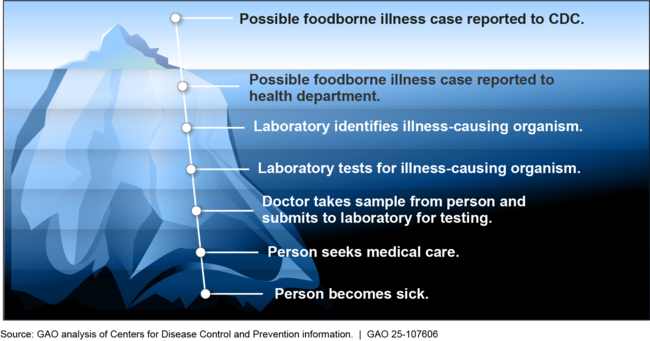Food Safety: Status of Foodborne Illness in the U.S.
Fast Facts
Millions of Americans get sick from foodborne illness every year. While many cases are mild, some cases can result in hospitalization, long-lasting complications, or even death.
In this Q&A, we reported that the safety and quality of the U.S. food supply is governed by at least 30 federal laws, collectively administered by 15 federal agencies. Federal agencies have developed some agency-specific and joint goals related to reducing foodborne illness, but most of these goals have not been met.
A national food safety strategy could help ensure agencies are working together in an effective and efficient manner to reduce foodborne illness.
This page was updated with a new photo on March 5, 2025.

Highlights
What GAO Found
Foodborne illness in the U.S. is a serious and continuing problem. A forthcoming study from the Centers for Disease Control and Prevention (CDC) estimates that about 10 million cases of foodborne illnesses each year in the U.S. are caused by six pathogens— including Salmonella, Listeria monocytogenes, Campylobacter, Clostridium perfringens, Shiga toxin-producing Escherichia coli (STEC), and norovirus. These illnesses result in about 53,300 hospitalizations and over 900 deaths annually. However, the precise magnitude of foodborne illness in the U.S. is unknown.
According to CDC, only a small proportion of all foodborne illnesses are diagnosed and reported to public health authorities. For example, CDC has estimated that foodborne Salmonella causes 29 illnesses for each case that is detected through laboratory testing. A case of foodborne illness may go undiagnosed if, for example, a sick person does not seek medical treatment.
Steps That Generally Occur Before a Possible Case of Foodborne Illness Becomes Visible to the Centers for Disease Control and Prevention (CDC)

Additionally, CDC largely relies on public health authorities across the country to voluntarily report cases of foodborne illness in their jurisdictions, but some possible cases of foodborne illness may not be reported for a variety of reasons. For example, according to CDC officials, some cases of foodborne illness may not be investigated or reported because of resource limitations at the state or local level.
CDC, the U.S. Food and Drug Administration (FDA), and U.S. Department of Agriculture’s (USDA) Food Safety and Inspection Service (FSIS) have taken some steps to develop agency-specific and joint goals related to reducing foodborne illness. However, the most recently available data show that FDA and FSIS have not met their goals—in one case, by a wide margin. Specifically, FSIS’s goal was to reduce the proportion of poultry samples with Salmonella serotypes commonly associated with human illness by 4 percent; however, the proportion of such samples increased by 22 percent that year.
In addition, the Healthy People 2030 initiative sets joint-agency performance metrics to reduce foodborne illness through a working group that includes CDC, FDA, and FSIS officials. However, the working group has reported limited progress. For example, six metrics aimed at reducing foodborne illness outbreaks are still under development and do not have defined baseline data to measure progress about 5 years into the 10-year cycle.
We previously reported on the need for a national strategy to guide federal efforts to address ongoing fragmentation and improve the federal food safety oversight system. We maintain that such a strategy could create an opportunity to further strengthen the oversight of the nation’s food supply, thereby reducing the economic and public health impacts of foodborne illness.
Why GAO Did This Study
Although the U.S. food supply is generally considered safe, tens of millions of Americans get sick from foodborne illness every year, and some die, according to estimates from CDC. According to CDC data, over 9,000 foodborne illness outbreaks were reported between 2011 and 2022 across all 50 states. Foodborne illness also has widespread economic consequences, costing Americans an estimated $75 billion (in 2023 dollars) annually in medical care, lost productivity, and premature deaths, including those associated with secondary chronic illnesses and conditions that develop after the initial illness, according to a study by researchers from USDA’s Economic Research Service and collaborators.
At least 30 federal laws govern the safety and quality of the U.S. food supply, both domestic and imported. Collectively, 15 federal agencies administer these laws, including CDC, FSIS, and FDA. The federal food safety oversight system is supplemented by states, localities, Tribes, and territories, which may have their own laws and agencies to address the safety and quality of food.
GAO has long reported that the fragmented nature of the federal food safety oversight system causes inconsistent oversight, ineffective coordination, and inefficient use of resources. Since 2007, GAO has cited federal oversight of food safety as a high-risk issue and identified several recommendations and matters for congressional consideration. In 2017, GAO called for the Executive Office of the President to develop and implement a national strategy for overseeing food safety. If implemented, this action could address GAO’s prior matters for congressional consideration about a government-wide performance plan and sustained leadership for food safety. As of January 2025, there were no plans to create a national strategy, according to officials from the Office of Management and Budget.
This report describes what is known about the magnitude of foodborne illness and associated foods, and federal goals associated with identifying and reducing foodborne illness. GAO reviewed and summarized information from CDC, FDA, and FSIS; visited laboratory facilities at each agency; and interviewed agency officials.
Recommendations
As of January 2025, six recommendations and five matters for congressional consideration that we consider significant for removing federal oversight of food safety from our High Risk List remain unaddressed.
